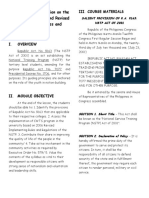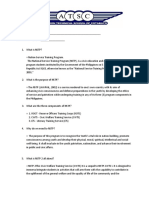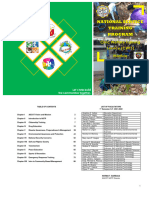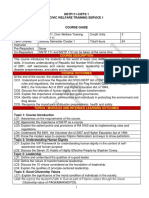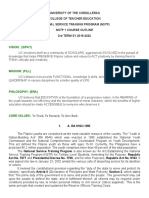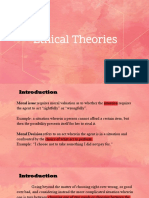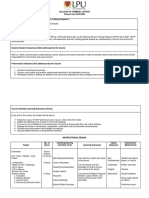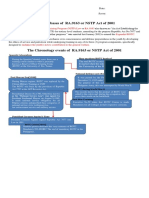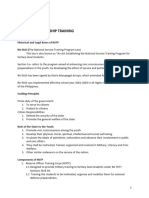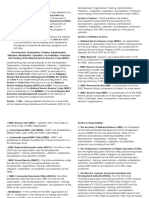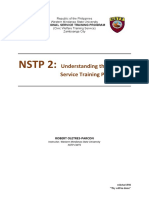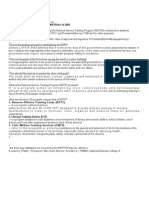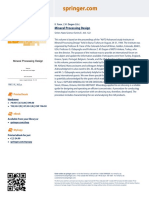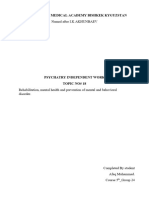0% found this document useful (0 votes)
79 views2 pagesAssignment 1
The National Service Training Program (NSTP) is a civic education program in the Philippines established in 2001 that aims to promote civic consciousness, nationalism, and public service involvement among tertiary students. It has three components: Reserve Officers' Training Corps, Civic Welfare Training Service, and Literacy Training Service. The program helps develop students' physical, intellectual, moral, social, economic, political, and environmental well-being while enhancing skills like leadership, communication, and community involvement. It was created in response to reforms needed for the Reserved Officers Training Corps and to fulfill the government and citizens' mutual responsibilities of national defense and service.
Uploaded by
Irish Joy Carlom PampolinaCopyright
© © All Rights Reserved
We take content rights seriously. If you suspect this is your content, claim it here.
Available Formats
Download as DOCX, PDF, TXT or read online on Scribd
0% found this document useful (0 votes)
79 views2 pagesAssignment 1
The National Service Training Program (NSTP) is a civic education program in the Philippines established in 2001 that aims to promote civic consciousness, nationalism, and public service involvement among tertiary students. It has three components: Reserve Officers' Training Corps, Civic Welfare Training Service, and Literacy Training Service. The program helps develop students' physical, intellectual, moral, social, economic, political, and environmental well-being while enhancing skills like leadership, communication, and community involvement. It was created in response to reforms needed for the Reserved Officers Training Corps and to fulfill the government and citizens' mutual responsibilities of national defense and service.
Uploaded by
Irish Joy Carlom PampolinaCopyright
© © All Rights Reserved
We take content rights seriously. If you suspect this is your content, claim it here.
Available Formats
Download as DOCX, PDF, TXT or read online on Scribd
/ 2
1. What is NSTP all about?
The National Service Training Program (NSTP), is a civic education and
defense preparedness program students instituted by the Government of the
Philippines on 5 January 2000 by virtue of Republic Act 9163, otherwise known
as the "National Service Training Program (NSTP) Act of 2001."
Republic Act 9163 enabled the establishment of National Service Training
Program for Tertiary Level students with an aim to promote civic consciousness
among the youth and inculcate in them the spirit of nationalism and advance their
involvement in public and civic affairs.
NSTP is a program designed to develop the youth’s physical, moral,
spiritual, intellectual, and social well-being and promote defense preparedness
and ethics of service while undergoing training in any of its three program
components. Its various components are specially designed to enhance the
youth’s active contribution to the general welfare.
2. What are the 8 core values of NSTP?
1. Physical (health-physical fitness, cleanliness, harmony with material
universe, art and beauty)
2. Intellectual (truth- knowledge, creative and critical thinking)
3. Moral (love- integrity. Honestly, self-worth, self esteem, personal discipline)
4. Spiritual (spiritually- faith in God)
5. Social, Family, Society (social responsibility- mutual love, respect, fidelity,
responsible parenthood, concern for others/common good, freedom/equality, social
justice/respect. Human rights- peace/active nonviolence, popular participation)
6. Economic (economic efficiency- thrift conservation of resources, work
ethics, self reliance, productivity, Scientific and technological knowledge
7. Political (nationalism- common identity, national unity, esteem,
commitment, civic consciousness/pride, bayanihan/solidarity, loyalty to country)
8. Protection of the Environment
3. How does NSTP help students?
Aside from passing our course, the program also help students to
enhance the skills on basic leadership with emphases on the ability to listen and
ability to communicate which were rated very important and very much benefited
among other training aspects of the program. NSTP also motivates us (students)
to actively involve ourselves in community development.
4. What are the 3 components of NSTP?
1.Reserve Officers Training Corps (ROTC)
Refers to the program component designed to provide military training in
order to motivate, train, organize and mobilize students for national defense
preparedness.
2. Civic Welfare Training Service (CWTS)
Refers to the program component or activities contributory to the general
welfare and betterment of life for the members of the community or the
enhancement of its facilities, especially those devoted to improving health,
education, environment, entrepreneurship, safety, recreation and moral of the
citizenry.
3. Literacy Training Service (LTS)
Refers to the program component designed to train students to teach
literacy and numeracy skills to school children, out-of-school youth and other
segments of society in need of their service.
5. Why was NSTP created?
The National Service Training Program (NSTP) Act of 2001 (R.A. 9163)
was enacted in response to public clamor for reforms in the Reserved Officers
Training Corps (ROTC) Program. This act affirms that the prime duty of the
government shall be to serve and protect its citizens. In turn, it shall be the
responsibility of all its citizens to defend the security of the State; thus, the
government may require each citizen to render personal, military or civil service.
In the pursuit of these goals, the youth shall be motivated, trained, organized,
and mobilized in military training, literacy, civic welfare, and other similar
endeavors in service to the nation.




